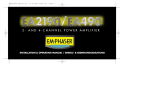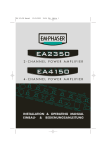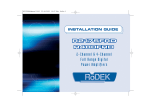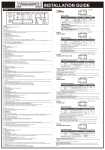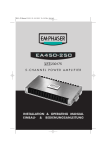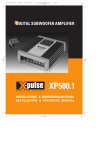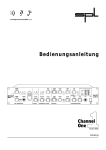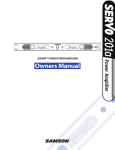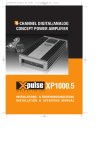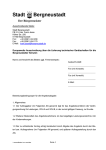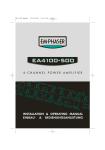Download EMPHASER EA490 Specifications
Transcript
EA490200 Manual 28.07.2000 16:11 Uhr Seite 1 5-CHANNEL POWER AMPLIFIER INSTALLATION & OPERATING MANUAL / EINBAU- & BEDIENUNGSANLEITUNG EA490200 Manual 2 28.07.2000 16:11 Uhr Seite 2 EA490200 Manual 28.07.2000 16:11 Uhr Seite 3 Contents/Inhalt Design Features . . . . . . . . . . . . . . . . . . . . . . . . . . . . . . 5 Description of Connections & Controls . . . . . . . . . . . . 6 Installation Plan . . . . . . . . . . . . . . . . . . . . . . . . . . . . . 8 Amplification Modes . . . . . . . . . . . . . . . . . . . . . . . . . . 9 Wiring / Electrical Connection . . . . . . . . . . . . . . . . . . 10 System Configuration 2-Channel Input Mode . . . . . 12 System Configuration 4-Channel Input Mode . . . . . 13 Crossover Settings . . . . . . . . . . . . . . . . . . . . . . . . . . 14 Specifications . . . . . . . . . . . . . . . . . . . . . . . . . . . . . . 16 Warranty Policy . . . . . . . . . . . . . . . . . . . . . . . . . . . . 31 Technischer Aufbau / Merkmale . . . . . . . . . . . . . . . 18 Beschreibung der Bedienungselemente . . . . . . . . . . 19 Montageplan . . . . . . . . . . . . . . . . . . . . . . . . . . . . . . . 21 Betriebsarten & Lautsprecheranschlüsse . . . . . . . . . 22 Verkabelung / Elektrischer Anschluss . . . . . . . . . . . 23 Konfigurationsvorschlag 2-Channel Input Mode . . . 25 Konfigurationsvorschlag 4-Channel Input Mode . . . 26 Einstellungen . . . . . . . . . . . . . . . . . . . . . . . . . . . . . . . 27 Technische Daten . . . . . . . . . . . . . . . . . . . . . . . . . . . . 29 Garantiebestimmungen /Garantiekarte . . . . . . . . . 31 3 EA490200 Manual 28.07.2000 16:11 Uhr Seite 4 EA490-200 Installation & Operation Manual Congratulations and thank you for choosing an EMPHASER 5-Channel Automotive Amplifier! You now own a product of uncompromising engineering philosophy, meticulous craftsmanship and unprecedented functionality, designed and thoroughly tested by the laboratories of EMPHASER Inc., Wyoming USA. To maximize the performance of your automotive audio system, we recommend that you acquaint yourself thoroughly with the capabilities and features of the EA490-200 amplifier. Please read this manual carefully before undertaking the installation of the amplifier. EMPHASER amplifiers are the result of outstanding craftsmanship and the highest quality control standards. When properly installed these amplifiers will provide you with many years of incomparable listening pleasure. 4 IMPORTANT NOTICE: In case you are installing your EMPHASER amplifier yourself, you should have your installation checked and approved by an authorized, professional EMPHASER dealer/installer, in order to qualify for full warranty protection and to reach maximum power and audio performance possible with your individual automotive audio system. EA490200 Manual 28.07.2000 16:11 Uhr Seite 5 EA490-200 Design Features ■ 5-Channel Amplifier, i.e. the all-in-one solution for a super compact and user friendly realization of a fully active 5-channel high-end car audio system. ■ Dash-Mount Remote Subwoofer Level Control. The EA 490200 comes complete with a compact remote "SUB LEVEL" control which can be mounted on or under the dashboard of your car. The "SUB LEVEL" control allows the individual adjustment of the subwoofer volume. The EA 490-200 will always store the last "Sub Level" adjustment in an EPROM chip. Therefore it is also possible to make one specific "Sub Level" setting after the installation of the system and then disconnect the control panel from the amplifier. ■ Two Independent MOSFET Power Supplies for Satellite and Subwoofer Amplification prevent any unwanted interference between the two amplifier sections. This effectively eliminates audible cross-talk from the power consuming bass amplifier onto the satellite channels. ■ Unique Hybrid Amplifier Switching Concept. The EA 490-200 incorporates two separate amplifier switching technologies: the satellite channels are using MOSFET (metal oxide semiconductor transistor) amplification, which is known for its outstanding performance in high-frequency reproduction. The amplification of the subwoofer channel is effected via a BJT (bipolar junction transistor) amplifier, a switching technology renowned for exceptional control and extended power handling. ■ 2 Ohm Stable Subwoofer Channel combined with an excellent damping factor guarantees well-controlled and contoured bass reproduction. ■ Fully Active Integrated Electronic Frequency Filtering for all amplifier sections. Both satellite sections (front and rear) feature individually adjustable high-pass filtering (HPF) between 50 and 250 Hz with a slope of 12 dB/oct. The independent low-pass (LPF) subwoofer channel is continuously adjustable from 40 to 120 Hz and features an exceptionally steep slope of 24 dB/oct. ■ Uncompromising Design and Construction using only the best electrical components including glass-fibre reinforced double-sided epoxy circuit boards featuring the latest SMD (surface mounted device) PCB technology and high current handling 24 K gold-plated solid brass power and signal connecting blocks/sockets and terminals. ■ Advanced Protection Circuitry 'sensing' short-circuits at the speaker outputs, DC voltage at the outputs and overheating of power electronics. Faulty connections or operating modes will cause the amplifier to shut-off immediately. ■ Operating Mode/ Status / Protection - LED signaling operation and/or problems e.g. short-circuits, electrical or thermal overload of the amplifier and DC voltage at the outputs. 5 EA490200 Manual 28.07.2000 16:11 Uhr Seite 6 ■ Adjustable Input Sensitivity accepting input voltages from 200 mV to 4 V allowing system combinations with almost every head-unit on the market. ■ Soft Start / Soft Turn-Off for safe and silent switch-on/switch-off of the amplifier. ■ External Fuses accessible from the amplifier bottom plate. 1. Front Input, LEFT Channel 2. Front Input, RIGHT Channel 3. LEVEL Sensitivity Front 4. FREQ. Hz Front Channels 5. LEVEL Sensitivity Rear 6. FREQ. Hz Rear Channels 7. INPUT MODE 2-CH/4-CH 8. Rear Input, LEFT Channel 9. Rear Input, RIGHT Channel 10. SUB FREQ. Subwoofer Channel 11. SUB LEVEL CONTROL INPUT 12. REAR SPEAKERS, - L +, - R + 13. FRONT SPEAKERS; - L +, - R + 14. SUBWOOFER (+/-) 15. GND 16. + 12V 17. REM 18. POWER/PROTECTION LED 1. Description of Connections & Controls 1 +2. RCA „FRONT INPUTS”/ „2-CHANNEL INPUT” („LEFT” & „RIGHT”) Low-level signal input for connection with the head-unit. This input section is also used in combination with the „INPUT MODE” switch in „2-CH” mode, i.e. when only two channels are fed to the amplifier (instead of 4). Please also consult section 2.2 und 2.6.1. 3. 4. Input Sensitivity Control for the front speakers/satellite system („FRONT LEVEL”) allowing to match the RCA line output of the head-unit to the amplifier input section. Please consult section 3.2. Highpass Frequency Control for the front speakers /front satellite system („FRONT FREQ.”), see section 3.1. EMPHASER EA490-200 5-Channel Amplifier Side View Input/Output Control Panel 6 EA490200 Manual 28.07.2000 16:11 Uhr Seite 7 5. Input Sensitivity Control for the rear speakers/satellite system („REAR LEVEL”) allowing to match of the RCA line output voltage of the headunit to the amplifier input section. Please consult section 3.2. 12. Speaker Connecting Terminal for the ,,REAR SPEAKERS” („R” and „L”) allowing the connection of one pair of 2 ohms rear satellites, see section 2.6.2. 6. Highpass Frequency Control for the rear speakers /rear satellite system („REAR FREQ.”), see section 3.1. 13. 7. „INPUT MODE” DIP-Switch with two positions: „4-CH” input setting if 4 pre-out channels (front and rear, each stereo) are fed to the EA 490-200. „2-CH” input setting in case the complete 5-channel system is only driven by 2 pre-out channels from the head-unit, see section 2.2. Speaker Connecting Terminal for the „FRONT SPEAKERS” („R” and „L”) allowing the connection of one pair of 2 ohms front satellites see section 2.6.2. 14. Speaker Connecting Terminal for the „SUBWOOFER” („+/-”) allowing the connection of a subwoofer with any load between 2 and 4 ohms, see section 2.6.3. 15. „GND” for connection to chassis ground or negative terminal of car battery, see section 2.6.5. 16. „+12 V” for connection to positive terminal of car battery, see section 2.6.4. 17. „REM” (Switching Contact) for the automatic (remote) turn-on / turnoff of the power amplifier from the head-unit's remote lead (or antenna control lead), see section 2.6.2. 18. Status-LED „POWER / PROTECTION” signalling operating mode or faults, see section 2.6.6. 19. „FUSES” located under the bottom for protection of the amplifierinternal electronics against overload or wrong operation / manipulation. 8 + 9. RCA „REAR INPUTS” („4-CHANNEL INPUT” Mode), „LEFT” & „RIGHT” Low-level signal input for connection with headunit. This input section is used in combination with the „INPUT MODE” switch in „4-CH” mode, i.e. when all 4 channels are fed to the amplifier. Please also consult section 2.2 und 2.6.1. 10. Lowpass Frequency Control for the subwoofer („SUB FREQ.”), see section 3.1. 11. AT&T / RJ-11 socket for the „SUB LEVEL CONTROL INPUT”, allowing connection of the remote dash-mount „Sub Level Control” unit, see section 2.6.1. 7 EA490200 Manual 28.07.2000 16:11 Uhr Seite 8 2.1 Installation Plan Before you proceed any further with the installation of the EA 490-200 amplifier, it is recommended to map out the complete audio system and the required wiring. Consider all electrical requirements, as well as safe mounting of the amp unit, sufficient ventilation, convenient accessibility of all fuses and gain/frequency knobs. Please note that - because of possible interference problems with the existing car wiring and electronics - especially the routing of the RCA signal cables and the chassis ground connection will have a profound influence on a trouble-free operation of the overall system. For optimum performance of this amplifier, it is recommended to use quality installation material. ■ ,,2-CH INPUT MODE” is used with head units featuring only one pair of RCA stereo pre-outs usually the rear pre-outputs (L&R). In this case, the amplifier will be switched into „2-CH” mode (DIP switch up, see fig. 1). This mode will let the amplifier distribute the incoming signal evenly between front and rear channels, plus the subwoofer channel. In „2-CH” input mode the front/rear fader option of the head-unit is de-activated; i.e. the relative levels between the front and rear satellite speaker system have to be set on the amplifier. The subwoofer channel always remains unaffected by the front/rear satellite setting.. fig. 1 If you have no or little experience with car audio installations, we strongly recommend to consult your nearest authorized EMPHASER dealer/installer. FRONT INPUTS LEFT RIGHT (2-CH INPUT) 2.2 Selecting Operating Modes FRONT LEVEL FREQ. 125 50Hz 250Hz („2-CH/4-CH INPUT MODE” switch) The EA 490-200 offers two basic operating modes, depending on the number of input channels used from the head-unit. Note: If your head-unit features a separate subwoofer RCA pre-out, it should not be used! 8 REAR INPUTS LEFT RIGHT REAR LEVEL FREQ. INPUT MODE 125 2-CH 50Hz 250Hz 4-CH SUB LEVEL CONTROL INPUT SUB FREQ. FREQ. INPUT MODE REAR SPEAKERS R L 125 FRONT SPEAKERS R 2-CHL SUBWOOFER GND +12V 80 40Hz 120Hz Hz 250Hz 4-CH L R RCA Inputs from head-unit Dip Switches Up for „2-CH” INPUT MODE EA490200 Manual 28.07.2000 16:11 Uhr Seite 9 ■ „4-CH INPUT MODE” is used with head units featuring two pairs of RCA stereo pre-outs i.e. front and rear pre-outputs (each L&R). In this case, the amplifier must be switched to „4-CH” input mode (DIP switch down, see fig. 2. As the „4-CH” input mode operates with 2 pairs of RCA inputs, it also provides full support of the fader control of the headunit. The subwoofer channel always remains unaffected by the front/rear satellite fader setting. Please note: The EA 490-200 is a 5-channel concept amplifier featuring high-pass filtering (HPF) for all satellite channels and low-pass filtering (LPF) for the subwoofer channel. Therefore these HPF and LPF filters may be individually adjusted in their respective cut-in/cut-off frequency range, but they cannot be switched off or by-passed completely. fig. 2 LEF FRONT INPUTS LEFT RIGHT (2-CH INPUT) FRONT LEVEL FREQ. 125 REAR INPUTS LEFT RIGHT REAR LEVEL 50Hz 250Hz FREQ. INPUT MODE 125 SUB LEVEL CONTROL INPUT SUB FREQ. 2-CH 80 50Hz 250Hz 4-CH REAR SPEAKERS R FREQ. INPUT MODE FRONT SPEAKERS L 125 R L 2-CH GND +12V 40Hz 120Hz L R L R Rear RCA Inputs The location of the amplifier should be carefully selected. In the interest of passive driver and passenger safety, the amplifier must be securely mounted. Check the suitability of your preferred amplifier location carefully before the installation. The mounting location should be either in the trunk or in the passenger compartment. The actual mounting surface should be completely flat. Any mounting position allowing for a good air stream across the cooling fins of the amplifier's heatsink will improve cooling (operating temperature!) and long-term stability dramatically. Make sure there is no wiring harness, fuel tank etc. behind or below the mounting surface, that may be damaged by the drilling of the holes for the amplifier mounting screws. After installation there should be a clearance of at least 5cm on all sides including the ventilated top of the amplifier heatsink. Make sure the unit is not exposed to direct sunlight, humidity, water, oil or other fluids that may enter the amplifier. SUBWOOFER 0 Hz 250 Hz 4-CH Front RCA Inputs 2.3 Location of the Amplifier Dip Switches Down for „4-CH” INPUT MODE 2.4 Amplification Modes The EA490-200 is a full concept amplifier, i.e. an all-in-one solution for a super compact and user friendly realization of a fully active high-end car audio amplification. The EA 490-200 allows the cross-over controlled amplification of a complete satellite/subwoofer audio concept, i.e. 2 pairs of satel9 EA490200 Manual 28.07.2000 16:11 Uhr fig. 3 R Seite 10 Speaker Connections L R L 2.5 Mounting the Amplifier GND Once the location for the amplifier is defined, use the unit as a template for the marking of the mounting holes with a pencil or felt-tip. The mounting holes should be pilot-drilled using a 2,5mm or 3mm drill. For the actual mounting the supplied rubber washers have to be pressed into the mounting holes from the top before inserting the supplied mounting screws. The rubber washers protect the amplifier from electrical ground-loops that can easily result in audible hum! 2.6.1 Wiring / Electrical Connection Front Satellites L&R min. 2 Ohms impedance Rear Satellites L&R min. 2 Ohms impedance Subwoofer 2–4 Ohms impedance lites front and rear component or coaxial systems) with an impedance of at least 2 ohms and one subwoofer channel for the bass reproduction at a minimum load impedance of 2 ohms. The front- and rear- speaker outputs of the EA490-200 are not bridgeable. For speaker connecting reference see fig.3 or the system configurations overleaf. Should you intend to use only one pair of satellites (plus subwoofer) with this amplifier, they have to be connected to the „Front Speakers” terminals with the amplifier switched to „4-CH INPUT MODE”. 10 IMPORTANT NOTICE: Disconnect the positive battery terminal (+12V) or remove the main fuse near the car battery before any wiring work! Please note that the power supply of the car must remain disconnected, until the entire wiring installation is completed. Speaker Impedance Specifications The heat dissipation capacity of this 5-channel amplifier has been designed to operate with two pairs of satellites with a minimum impedance of 2 ohms (per satellite) and a subwoofer channel with a minimum impedance of 2 ohms. These minimum impedances must not be decreased any further, as EA490200 Manual 28.07.2000 16:11 Uhr Seite 11 the resulting excess heat generation inside the amplifier will cause the thermal protection circuitry to shut-off the amplifier. ■ Use rubber grommets when running cables through any metal or sharp plastic to prevent accidental shorting or shearing. Make sure the cables do not interfere with normal operation of the vehicle. ■ Especially the music signal cables (RCA interconnects) should be kept far away from any potential sources of electrical interference e.g. electronic vehicle management systems (engine computers, relays etc.) fuel pumps, wiring harnesses etc.! 2.6.2 Carefully run the audio signal and remote switching cables and the remote bass control cable from the head-unit or dashboard to the amplifier. The audio signal cables should be routed completely separate from the power cables. Use only double or triple shielded quality cables! Connect the remote (turn on/turn off) lead to the respective output/input of the head-unit and the amplifier. If your head-unit does not have a separate remote lead you may also use the antenna remote output. Now you can connect the audio cable to the respective outputs on the head-unit and the inputs of the amplifier. Mount the remote ”Sub Level CONTROL” unit in a convenient position on or under the dashboard and connect the cable between the remote control unit and the amplifier (”SUB LEVEL CONTROL INPUT”). 2.6.3 Connect the loudspeaker wires as shown in fig. 3. Use good quality speaker wires of minimum 1,5mm2 - preferably 2,5mm2 crosssection. Start with loosen the allen screws of the respective screw terminals. When stripping the wires for connection, remove approximately 8mm of the insulation and insert the bare ends into the corresponding speaker terminal output on the amplifier. Be sure to follow correct polarity of each wire. Tighten the allen screws of the amplifier. 2.6.4 Run the positive power cable („+12 V”) directly from the positive terminal of the car battery to the amplifier. To protect your car audio system and your entire car against electrical fire hazards from a short-circuit of the main power cable with chassis ground, you must insert a main fuse (holder) within the first 30cm of the battery. The fuse type/value should be matching the limitations of your main power cable and the requirements of your car audio system, in case of the EA490-200, the minimum vakue is 60 Ampere! Do not insert the main fuse until the entire installation is completed! 2.6.5 Now you route the ground cable to the amplifier. Try to find a GND contact very close to the amplifier. The ground power cable must have the same cross-section as the positive power cable. It is recommended to use a corrosion-resistant gold-plated power ring between the ground cable and the chassis ground point. The contact point on the car chassis should therefore be solid and clean, i.e. free from rust or paint etc. A bad 11 EA490200 Manual 28.07.2000 16:11 Uhr Seite 12 System Configuration 2-CHANNEL INPUT MODE EA490-200 CD/MD CHANGER SUB LEVEL CONTROL REMOTE PANEL CONTROL SUB LEVEL CONTROL Please note! all Satellites are driven in High-Pass Mode Subwoofer channel is driven in Low-Pass Mode all Satellites must be 2 Ohms or more Subwoofer may be 2 - 4 Ohms 2-Channel Input Mode does not support fader control on head-unit ● ● ● ● ● 1 PRE-OUT HEAD-UNIT TWEETER TWEETER G r e a t A m e r i c a n C a r A u d i o G r e a t G r e a t A m e r i c a n C a r A m e r i c a n C a r A u d i o A u d i o G r e a t PASSIV X-OVER A m e r i c a n C a r A u d i o PASSIV X-OVER BASS/MIDRANGE BASS/MIDRANGE G r e a t G r e a t A m e r i c a n C a r A u d i o COAXIAL/TRIAXIAL SYSTEM 12 PASSIV INLINE X-OVER A m e r i c a n C a r A u d i o A u d i o A u d i o C a r C a r A m e r i c a n A m e r i c a n G r e a t G r e a t PASSIV INLINE X-OVER TRUNKBOX SUBWOOFER COAXIAL/TRIAXIAL SYSTEM EA490200 Manual 28.07.2000 16:11 Uhr Seite 13 System Configuration 4-CHANNEL INPUT MODE EA490-200 CD/MD CHANGER ● ● ● ● ● 2 PRE-OUT FRONT & REAR SUB LEVEL REMOTE CONTROL SUB LEVEL CONTROL Please note! HEAD-UNIT TWEETER all Satellites are driven in High-Pass Mode Subwoofer channel is driven in Low-Pass Mode all Satellites must be 2 Ohms or more Subwoofer may be 2 - 4 Ohms 4-Channel Input Mode supports fader control on head-unit TWEETER G r e a t A m e r i c a n C a r A u d i o G r e a t G r e a t A m e r i c a n C a r A m e r i c a n C a r A u d i o A u d i o G r e a t PASSIV X-OVER A m e r i c a n C a r A u d i o PASSIV X-OVER BASS/MIDRANGE BASS/MIDRANGE G r e a t G r e a t A m e r i c a n C a r A u d i o COAXIAL/TRIAXIAL SYSTEM PASSIV INLINE X-OVER A m e r i c a n C a r A u d i o A u d i o A u d i o C a r C a r A m e r i c a n A m e r i c a n G r e a t G r e a t PASSIV INLINE X-OVER TRUNKBOX SUBWOOFER COAXIAL/TRIAXIAL SYSTEM 13 EA490200 Manual 28.07.2000 16:11 Uhr Seite 14 2.6.6 Close the electrical circuit by inserting the main fuse. After turning-on the head-unit, the „Power/Protection” LED of the amplifier should light-up green. If the LED is red, the installation is faulty, turn the headunit off immediately and re-check steps 2.6.1 to 2.6.5. The same applies if the amplifier LED does not light up at all. will be the reproduction of the mid-bass frequencies and the power-handling of the satellites (cone excursion of the mid/woofers!). If the satellite cross-over frequency is too low, the mid-bass reproduction will be increased, but the power-handling will decrease at the same time. If the cross-over frequency is set too high, the mid-bass reproduction will become 'thin', while the powerhandling of the satellite speakers will increase. Try to find the settings that will suit your personal listening preferences and the physical and electrical capabilities of your equipment best. 3.1 Cross-Over Settings As a general rule you can get good results around the following High-Pass Recommendations: ground contact reduces the voltage, resulting in reduced power output and high distortion. The EA490-200 is a concept amplifier, therefore the actual speaker outputs will receive HPF or LPF filtered amplified signals, and the speakers will only have to work in the frequency bands they will reproduce best. Before the respective sensitivity levels of the individual amplification systems can be set, it is advisable to set the system appropriate cross-over frequencies for all speaker systems. Satellite High-Pass Frequencies (Front & Rear „FREQ. Hz”) It is recommended to set the high-pass cross-over frequency between 50 and 250 Hz using the „FREQ. Hz” controls. The appropriate setting should be determined by ear. The two most important factors for the individual adjustment 14 Front Satellite Speaker System („FRONT FREQ.”) X-Over Freq. 10 cm/4” Coaxial or Separate Component System 13 cm/5” Coaxial or Separate Component System 16 cm/6” Coaxial or Separate Component System 90 Hz 80 Hz 70 Hz Rear Satellite Speaker System („REAR FREQ.”) X-Over Freq. 10 cm/4” Coaxial or Separate Component System 13 cm/5” Coaxial or Separate Component System 16 cm/6” Coaxial or Separate Component System 100 Hz 120 Hz 130 Hz EA490200 Manual 28.07.2000 16:11 Uhr Seite 15 Subwoofer Low-Pass Frequency („SUB FREQ.”) Ideally, the low-pass (LPF) cut-off frequency for the subwoofer should be set between 50 to 90 Hz. The actual setting should be 'played by ear', i.e. set the „SUB FREQ.” control in such a way that the bass reproduction is stiff and rich, while still delivering a good and solid low-end extension. 3.2 Input Sensitivity Settings („LEVEL”) To reach a maximum noise-free dynamic headroom from each individual head unit/amplifier/speaker combination, it is important to set the respective input sensitivity controls („LEVEL”) correctly. On the one hand the sensitivity settings determine the actual signal-to-noise ratio, on the other hand the sensitivity setting also controls the maximum distortion-free SPL (sound pressure level) possible with a specific car audio system. 3.2.1 Tips for Appropriate Sensitivity Settings Before you start, all tone controls (Bass, Mid, Treble) and all fader and balance controls on the head unit have to be set to neutral or center position. The „Loudness” function must be deactivated. Turn both satellite „LEVEL” controls (Front and Rear) on the amplifier counterclockwise to their minimum positions. Turn-on your head-unit and keep the volume control to the minimum! Press the „DOWN” button of the sub remote control unit until you have reached zero level. Now you set the volume control of your head-unit to approximately 3/4 of full volume, while playing a dynamic track from a CD. Slowly increase the sub channel level control by pressing the „UP” button until you can just about hear distorted bass sounds. Now you reduce the main volume level on the head-unit to a medium listening level. Now you start turning up the FRONT satellite „LEVEL” control clockwise, until you have reached a good tonal balance between the front satellites and the sub channel, a slight forwardness of the bass range should be preferred, as this will be compensated later by normal driving noises. Now you turn up the REAR satellite „LEVEL” control clockwise until you feel that you have reached an appropriate sound level in the back of the car, so that the total sound reproduction becomes smooth and homogenous. Finally you should fine-tune the LPF cross-over frequency on the amplifiers „SUB FREQ.” control. Obviously, it is also possible to make a fixed sub channel setting by first setting the desired subwoofer level on the remote „SUB LEVEL CONTROL” and then unplugging the remote cable from the amplifier. The last sub level setting will be automatically stored by the amplifier. 15 EA490200 Manual 28.07.2000 16:11 Uhr 4. Specifications EA490-200 5-Channel Amplifier Seite 16 Rated Power Output (RMS) Front / Rear Channels and Subwoofer Channel at 4 ohms (13.8 V) (THD = <1 %) Rated Power Output (RMS) Front / Rear Channels at 2 ohms and Subwoofer Channel at 2 ohms (13.8 V) (THD < = 0,1 %) 4 x 125 W (Satellites) / 1 x 300 W (Subwoofer) Damping Factor Front / Rear Channels Subwoofer Channel at 4 Ohms > 200 > 300 Signal-to-Noise Ratio (A-Filter) > 100 dB Frequency Response (Front- / Rearplus Subwoofer Channel) (+0 dB / - 1 dB) Channel Separation Input Sensitivity Integrated Cross-Over/Filtering Slope Rate Cross-Over Frequency 16 4 x 90 W (Satellites) / 1 x 200 W (Subwoofer) 10 Hz - 40 kHz > 55 dB 200 mV - 4 V High-Pass/ Front & Rear Channels 12 dB / Octave continuously adjustable 50 - 250 Hz Fuse 2 x 30 A Dimensions W x H x D 368 x 53 x 208 mm Low-Pass Subwoofer Channel 24 dB / Octave continuously adjustable 40 - 120 Hz EA490200 Manual 28.07.2000 16:11 Uhr Seite 17 EA490-200 Bedienungs- und Installationsanleitung Herzlichen Glückwunsch! Wir gratulieren Ihnen zum Kauf der EMPHASER EA 490-200 Fünfkanalendstufe, einem Top-Produkt von EMPHASER Inc., Wyoming / USA. Ausgestattet mit einem kompromisslosen technischen Aufbau, setzt dieser Fünfkanal Car-Amp Masstäbe bezüglich Leistungsabgabe, Klangqualität und Bedienungsfreundlichkeit. Damit Sie die Wiedergabequalität und die Leistungsfähigkeit dieses Verstärkers voll ausschöpfen können, bitten wir Sie, sich eingehend mit den Möglichkeiten und technischen Features dieses Verstärkers vertraut zu machen. Lesen Sie deshalb die nachfolgenden Abschnitte sorgfältig durch und bewahren Sie diese Bedienungsanleitung für allfällige, vielleicht später auftauchende Fragen auf. korrekte Installation vorausgesetzt, viele Jahre unvergleichlichen Hörspass bereiten. Falls Sie weitere Fragen bezüglich der Anschlussmöglichkeiten des Gerätes oder dessen Installation haben, lassen Sie sich von Ihrem EMPHASER Händler beraten. WICHTIG FÜR IHREN GARANTIE-SCHUTZ: Wenn Sie den Einbau Ihres Auto-HiFi Systems selbst vornehmen, lassen Sie dieses von Ihrem EMPHASER-Händler auf fachgerechte Installation überprüfen und auf der Garantiekarte bestätigen. Damit sichern Sie sich Ihre Garantieleistungen und stellen sicher, dass die Anlage ihre volle Klangqualität und Leistungsfähigkeit erreicht. EMPHASER Car-HiFi Verstärker sind Produkte, die in Handarbeit mit höchsten Qualitätsstandards und Kontrollen hergestellt werden. Sie werden Ihnen, 17 EA490200 Manual 28.07.2000 16:11 Uhr Seite 18 Technischer Aufbau / Merkmale nimmt ein für seine hervorragende Kontrolle und Leistungsfähigkeit berühmter BJT-Verstärker. ■ Fünfkanalverstärker zur Realisierung eines einbaufreundlichen und klangstarken 5-Kanal Subwoofer/Satelliten Konzeptes, z.B. bestehend aus zwei Paar Komponentenlautsprecher (Front- und Heckbereich) und einem Subwoofer. ■ 2 Ohm-Stabilität der Satellitenkanäle und des Subwooferkanals. Dies bewirkt im Zusammenspiel mit dem exzellenten Dämpfungsfaktor enorme Leistungsreserven und absolute Kontrolle des angeschlossenen Subwoofers und der Satellitenlautsprechern. ■ Subwooferpegelregelung über externe Fernbedienung. Das im Cockpit des Fahrzeuges frei montierbare kleine „Sub Level CONTROL„ Bedienteil ermöglicht die Fernbedienung der Lautstärke des Subwoofers. Dadurch kann der absolute Bass-pegel der Quelle (Cassette, MD oder CD), dem Geschmack und der Aufnahme während der Fahrt angepasst werden. Der zuletzt eingestellte Wert wird digital im EPROM-Chip gespeichert, sodaß z.B. auch eine einmalige Einstellung vorgenommen werden kann und das Bedienteil am Verstärker anschliessend wieder abgezogen wird. ■ Integrierte elektronische Frequenzweichen mit einer Flankensteilheit von 12 dB/Okt. bei den hochpassgefilterten Front- und Rear- Kanälen und einem 24 dB/Okt. Tiefpassfilter für den Subwooferkanal. Zusätzlich stufenlos regelbare Trennfrequenzen im Bereich zwischen 50 bis 250 Hz bei den Satellitenkanälen und einem Bereich von 40 bis 120 Hz beim Subwooferkanal. ■ Zwei einzelne vollständig getrennte MOSFET - Netzteile für Satelliten- und Subwoofer- Verstärkersektionen verhindern eine gegenseitige Beeinflussung der einzelnen Verstärkungszüge. Dies verhindert ein klanglich ungünstiges Übersprechen des leistungsintensiven Bassbereiches auf die Satellitenkanäle. ■ Spezielle Schaltungstechnik: Die Verstärkung der vier Satellitenkanäle erfolgt mit für ihre ausgezeichneten klanglichen Eigenschaften bekannten MOSFET-Verstärker, die Verstärkung des Subwooferkanals über18 ■ Kompromissloser Aubau und Konstruktion durch den Einsatz von neuesten Schaltungstechniken und ausschliessliche Verwendung von hochwertigsten Materialien in der Fertigung, wie z.B. SMD-bestückte doppelseitig kaschierte Glasfaserepoxydharzplatinen oder hochstromfähige, 24K hartvergoldete Strom- und Lautsprecheranschlussblöcke aus Massivmessing. ■ Intelligente Schutzschaltungwelche Kurzschlüsse an den Lautsprecherausgängen, Gleichspannung im Ausgangssignal und überhöhte Betriebstemperatur erkennt. Fehlerhafte Betriebszustände führen zum sofortigen Abschalten des Gerätes. ■ Betriebsanzeige / Protection - LED zeigt Kurzschlüsse, elektrische- EA490200 Manual 28.07.2000 16:11 Uhr Seite 19 und thermische Überlastung des Verstärkers und Gleichspannung an den Anschlussklemmen an. 1. Beschreibung der Bedienungselemente ■ Regelbare Eingangsempfindlichkeit mit einem breiten Einstellbereich von 200 mV bis 4 V. Ermöglicht dadurch die Kombination mit prakt. allen Steuergeräten. 1+2. Cinch Eingangsbuchsen „FRONT INPUTS” („LEFT” & “RIGHT”; linker und rechter Kanal vorne). NF-Signal Eingang für den Anschluss der Cinch Front-Ausgänge des Steuergerätes (siehe Abschnitt 2.2 und 2.6.1) ■ Soft Start / Soft Turn-Off für sanftes Ein- und Ausschalten des Verstärkers ohne Störgeräusche. 1 + 2. FRONT INPUTS: LEFT & RIGHT 3. FRONT LEVEL 4. FRONT FREQ. 5. REAR LEVEL 6. REAR FREQ. 7. INPUT MODE: 2-CH od. 4-CH 8 + 9. REAR INPUTS: LEFT & RIGHT 10. SUB FREQ. 11. SUB LEVEL CONTROL INPUT 12. REAR SPEAKERS: R und L 13. FRONT SPEAKERS: R und L 14. SUBWOOFER (+ /-) 15. GND 16. + 12 V 17. REM 18. POWER / PROTECTION 3. Eingangsempfindlichkeitsregler der Front-Kanäle („FRONT LEVEL”) für die Anpassung an die Ausgangsspannung des Steuergerätes (siehe Abschnitt 3.2). 4. Regler zum Einstellen der Hochpass-Trennfrequenz der FRONT SPEAKERS („FRONT FREQ.”) an der integrierten elektronischen Frequenzweiche (siehe Abschnitt 3.1). EMPHASER EA490-200 Fünfkanalendstufe Anschlusseite 19 EA490200 Manual 28.07.2000 16:11 Uhr Seite 20 Eingangsempfindlichkeitsregler der Rear-Kanäle („REAR LEVEL”) für die Anpassung an die Ausgangsspannung des Steuergerätes (siehe Abschnitt 3.2). 13. 6. Regler zum Einstellen der Hochpass-Trennfrequenz der REAR SPEAKERS („REAR FREQ.”) an der integrierten elektronischen Frequenzweiche (siehe Abschnitt 3.1). 14. Lautsprecheranschlussterminal „SUBWOOFER” („+/-”) für den Anschluss von einem Subwoofer mit 4 Ohm oder 2 Ohm Abschlussimpedanz (siehe Abschnitt 2.6.2). 7. Eingangs-/Betriebswahl-Schalter „INPUT MODE” für die Ansteuerung des Verstärkers mittels eines oder zwei Paar („2-CH od. 4-CH”) Cincheingängen (siehe Abschnitt 2.2). 15. „GND” für den Anschluss an die Chassis-Masse des Kfz (siehe Abschnitt 2.6.5). 8+9. Cinch Eingangsbuchsen „REAR INPUTS” („LEFT” & „RIGHT”; linker und rechter Kanal hinten). NF-Signal Eingang für den Anschluss der Cinch Rear-Ausgänge des Steuergerätes (siehe Abschnitt 2.2 und 2.6.1) 20 Lautsprecheranschlussterminal „FRONT SPEAKERS” („R” und „L”) für den Anschluss von einem Paar 4 Ohm Front-Satellitenlautsprecher (siehe Abschnitt 2.6.2). 5. 10. Regler zum Einstellen der Tiefpass-Trennfrequenz („SUB FREQ.”) an der integrierten elektronischen Frequenzweiche (siehe Abschnitt 3.1). 11. Buchse „SUB LEVEL CONTROL INPUT” für den Anschluss des Kabels vom externen „SUB LEVEL CONTROL”/Basspegel-Regler (siehe Abschnitt 2.6.1) 12. Lautsprecheranschlussterminal „REAR SPEAKERS” („R” und „L”) für den Anschluss von einem Paar 4 Ohm Rear-Satellitenlautsprecher (siehe Abschnitt 2.6.2). 16. „+ 12 V” für den Anschluss an den Pluspol der Autobatterie (siehe Abschnitt 2.6.4). 17. „REM” (Remote) Anschluss für die Ein- bzw. automatische Abschaltung des Verstärkers über den Amp- oder Antenna-Remote Anschluss des Steuergerätes (siehe Abschnitt 2.6.2). 18. Betriebszustands-LED „POWER / PROTECTION” signalisiert den Betriebszustand (siehe Abschnitt 2.6.6). 19. „FUSES” (Sicherungen) für die interne Absicherung des Verstärkers gegen Überlastung und Fehlmanipulation. Verwenden Sie für dieses Modell nur 30 Ampere Sicherungen zugänglich über die Bodenplatte des Verstärkers. EA490200 Manual 28.07.2000 16:11 Uhr Seite 21 2.1 Montageplan Bevor Sie mit der Montage beginnen, erstellen Sie am besten eine kurze Anschluss- und Installationsskizze. Zu berücksichtigen gilt es dabei hauptsächlich die Kabelverläufe und den Installationsort des Car-Amps. Beachten Sie bitte, dass die Kabelführung sowie der Massepunkt einen entscheidenden Einfluss auf das störungsfreie Funktionieren Ihrer Anlage hat. Besondere Aufmerksamkeit verdient auch die korrekte Plazierung des Verstärkers (ausreichende Luftzufuhr!), die richtige Stellung des Input Mode Wahlschalters für die Ansteuerung des Verstärkers über ein Paar Cinchkabel (via Front Ausgang vom Radio), oder über zwei Paar Cinchkabel (Front + Rear Ausgang vom Radio), sowie die Qualität des verwendeten Zubehörs zur fachgerechten Installation (Stromkabel, Cinchkabel, Sicherungshalter, Verteilerblöcke, etc). ■ „2-CH INPUT MODE” Wenn Ihr Steuergerät nur über einen Stereo Cinchausgang verfügt, können Sie durch die Einstellung des DIP-Schalters gemäss Abb.1 bewirken, dass der Verstärker das NF-Eingangssignal intern auf die FrontRear- und Subwooferkanäle gleichzeitig aufteilt. Eine Fadingmöglichkeit besteht in dieser Betriebsart natürlich nicht. Die Front- /Rear- Fader Einstellung muss über die Eingangsempfindlichkeitsregler erfolgen. Die separate Einstellmöglichkeit der Front- und Rear- Hochpassfrequenzen bleibt aber voll erhalten. Abb.1 FRONT INPUTS LEFT RIGHT (2-CH INPUT) 2.2 Wählen der Betriebsart FRONT LEVEL FREQ. 125 50Hz 250Hz REAR INPUTS LEFT RIGHT REAR LEVEL FREQ. INPUT MODE 125 2-CH 50Hz 250Hz 4-CH SUB LEVEL CONTROL INPUT SUB FREQ. 125 REAR SPEAKERS L 2-CH FRONT SPEAKERS R L SUBWOOFER GND +12V 40Hz 120Hz (am „INPUT MODE” Schalter) Entsprechend der Verwendung eines Steuergerätes mit nur einem Cinchausgang oder eines Steuergerätes mit Front- und Rear- Cinchausgängen, wählen Sie gemäss Abbildung auf der untenstehenden Skizze die Stellung des DIP-Schalters an der Anschlussleiste des Verstärkers (siehe Abbildung 1 und 2). FREQ. INPUT MODE R 80 Hz 250Hz 4-CH Cinch-Eingänge vom Steuergerät (L&R) L Mikro-Schalter oben für „2-CH” Eingangs-Betrieb R 21 EA490200 Manual 28.07.2000 16:11 Uhr Seite 22 ■ „4-CH INPUT MODE” Falls Ihr Steuergerät über zwei Stereo-Cinchausgänge verfügt (Front und Rear), sollten Sie die DIP-Schaltereinstellung gemäss der Abb. 2 wählen. Dadurch wird auch die Benutzung der Fading-Möglichkeit am Steuergerät zwischen Front- und Rear- Kanälen gewährleistet. Der Subwooferpegel entsteht durch die interne Summierung der Front- und Rearkanälen in der elektronischen Frequenzweiche. Der effektive Subwooferpegel bleibt daher beim Fading zwischen vorne und hinten unverändert! N.B. Die Hochpassfilter der beiden Front- und Rear Satellitenkanäle, sowie das Tiefpassfilter des Subwooferverstärkers liegen immer im Signalweg und können nicht abgeschaltet oder umgangen werden. Abb. 2 FREQ. INPUT MODE FRONT INPUTS LEFT RIGHT (2-CH INPUT) FRONT LEVEL FREQ. 125 50Hz 250Hz REAR INPUTS LEFT RIGHT REAR LEVEL FREQ. INPUT MODE 125 125 REAR SPEAKERS SUB LEVEL CONTROL INPUT R SUB FREQ. 2-CH 2-CH L FRONT SPEAKERS R L GND +12V 2.4 Betriebsarten & Lautsprecheranschlüsse 40Hz 120Hz Hz 250 Hz 4-CH Rear Eingänge Cinch Front Eingänge Cinch L 22 R L R Der Verstärker muss gut plaziert, und im Interesse der passiven Sicherheit stabil befestigt werden. Prüfen Sie, ob die gewählte Montagefläche eben und stabil genug zur sicheren Befestigung des schweren Verstärkers ist. Als Montageort eignet sich z.B. ein Platz im Kofferraum oder unter dem Fahrer- oder Beifahrersitz, bzw jeder andere Ort, der eine saubere Installation ermöglicht. Stellen Sie eine ausreichende Belüftung respektive Kühlung der Endstufe sicher (mindestens 5 cm Freiraum oberhalb und auf den Seiten der AluKühlkörper Rippen). Vermeiden Sie Montageorte mit "unbekanntem Hintergrund". Es könnten sich ein Benzintank, hydraulische Bremsleitungen, Kabel etc. dahinter verbergen! Achten Sie auch auf einen trocken, gegen mechanische Einwirkungen geschützten Installationsort, der auch nach der Endmontage noch für die Bedienung und Einstellung (Trennfrequenz- und Eingangsempfindlichkeits Regelung) des Verstärkers gut zugänglich ist. SUBWOOFER 80 50Hz 250Hz 4-CH 2.3 Einbauort Mikro-Schalter unten für „4-CH” Eingangs-Betrieb Die EA490-200 ist eine Vollkonzept-Endstufe, d.h. mit einer einzigen Endstufe kann ein vollständiges 5-Kanal System mit zwei unabhängigen Stereo-Satelliten-Paaren (mit min. 2 Ohm Impedanz) für vorn und hinten und einem getrennten Subwoofer (mit 2-4 Ohm Impedanz) angesteuert werden. EA490200 Manual 28.07.2000 16:11 Uhr Seite 23 Lautsprecher-Anschlüsse Abb. 3 R L „Front” Satelliten L&R min. 2 Ohm Impedanz R einem geeigneten Filzstift die Bohrposition der vier Befestigungslöcher. Mit der gebotenen Vorsicht bohren Sie nun die angezeichneten Löcher mit einem 2,5 oder 3 mm Bohrer. Drücken Sie die beigelegten Gummitüllen in die Befestigungslöcher Ihres Verstärkers!! Ein Masseschluss des Verstärkergehäuses auf die Kfz-Masse muss unbedingt vermieden werden! (Brummschleife!) Legen Sie nun den Verstärker auf die vorgebohrten Löcher und stecken Sie die Schrauben von oben in die Befestigungslöcher des Verstärkers. Ziehen Sie die Schrauben gleichmässig an und überprüfen Sie abschliessend den einwandfreien Sitz des Verstärkers. L „Rear” Satelliten L&R min. 2 Ohm Impedanz Subwoofer 2-4 Ohm Impedanz Die jeweiligen „Front-“ und „Rear-“Kanäle können nicht gebrückt werden (siehe Abb. 3 und die Systemkonfigurationsvorschläge im folgenden Abschnitt). Wenn Sie beabsichtigen nur ein Paar Satellitenlautsprecher einzusetzen, sind diese an den mit "FRONT SPEAKERS" bezeichneten Lautsprecherausgängen im "4-CH" Eingangsbetrieb anzuschliessen. 2.5 Befestigung des Verstärkers Halten Sie den Verstärker an den gewünschten Ort und markieren Sie mit 2.6.1 Verkabelung / Elektrischer Anschluss ACHTUNG! Entfernen Sie vor Beginn der Arbeiten das Pluskabel vom Pluspol der Batterie !! Anmerkung: Die Wärmeabfuhrkapazität dieser Fünfkanalendstufe ist für den Betrieb von Satellitenlautsprechern mit einer minimalen Impedanz von 2 Ohm und einer Abschlussimpedanz von im Minimum 2 Ohm im Subwooferkanal ausgelegt. Diese Impedanzwerte dürfen auf keinen Fall unterschritten werden, da sonst die resultierende übermässige Wärmeentwicklung zum Ansprechen der Thermo-Sicherung führt, welche das Gerät aus Sicherheitsgründen abschaltet. 23 EA490200 Manual 28.07.2000 16:11 Uhr Seite 24 ■ Verwenden Sie beim Einziehen der Stromkabel entsprechende Kabeltüllen aus Gummi um ein Durchscheuern an Blechkanten, respektive den dadurch resultierenden Kurzschluss auf Chassismasse zu vermeiden! ■ Speziell die musiksignalführenden (Cinch-) Kabel müssen soweit wie möglich von allen potentiellen "elektrischen Störsendern" wie Bordcomputer, Benzinpumpe, Kabelbäumen, Stromversorgungskabel für die Beleuchtung, etc. verlegt werden! 2.6.2 Verlegen Sie das Cinchkabel, das Fernbedienungskabel für die Subwooferpegel-Regelung und das Remote-Kabel vom Steuergerät zur Endstufe. Diese Kabel sollten unbedingt räumlich getrennt von der Stromzuführung des Verstärkers eingezogen werden. Verwenden Sie mindestens doppelt oder besser dreifach geschirmte Cinch-Kabel! Schliessen Sie das Remote-Kabel an das mit "Antenna-Rem." oder "Amplifier-Rem." bezeichnete Kabel Ihres Steuergerätes an. Anschliessend stecken Sie die Cinchkabel in die Cincheingangsbuchsen des Verstärker ein. Nun wird die "SUB LEVEL CONTROL" Steuereinheit in Griffnähe angeschraubt und der Stecker in die am Verstärker vorgesehene Buchse (SUB LEVEL CONTROL INPUT) eingesteckt. 24 2.6.3 Schliessen Sie nun die Lautsprecher Kabel an. Verwenden Sie Lautsprecherkabel mit mindestens 1,5 mm2 , besser aber 2,5 mm 2 Querschnitt. Entfernen Sie ca. 8 mm der Isolierung des LS-Kabels und beachten Sie die richtige Polung der Lautsprecherkabel (Plus auf Plus, Minus auf Minus) Ziehen Sie die LS-Schraublemmen satt an. 2.6.4 Verlegen Sie nun das Pluskabel direkt von der Batterie zum Verstärker. Innerhalb der ersten 30 cm nach dem Pluspolklemmenabgriff muss eine Hauptsicherung angebracht werden zur Absicherung des Pluskabels gegen Kurzschluss auf Fahrzeug-Masse und dadurch resultierendem Kabelbrand (Vorschrift der Kfz-Versicherungen!!) Verwenden Sie eine dem Stromkabelquerschitt entsprechende Sicherung (mindestens 60 A). 2.6.5 Nun schliessen Sie dass Minuskabel am Verstärker an. Versuchen Sie dieses Kabel so kurz wie möglich zu halten. Es sollte denselben Querschnitt wie das Pluskabel besitzen. Verwenden Sie für den Massepunktanschluss einen vergoldeten Ringkabelschuh, und achten Sie auf eine perfekt gesäuberte blanke Metalloberfläche (schlechte Massepunkte sind für über 90 % aller Fälle der auftretenden Störungen verantwortlich). Ein schlechter Massepunkt bedeutet nicht nur erhöhte Störungsanfälligkeit, sondern auch drastisch reduzierte Ausgangsleistung (durch früh einsetzende Verzerrungen). 24 EA490200 Manual 28.07.2000 16:11 Uhr Seite 25 KONFIGURATIONSVORSCHLAG 2-Channel Input Mode EA490-200 CD/MD-WECHSLER ● ● ● ● ● 1 PRE-OUT SUB LEVEL REMOTE CONTROL SUB LEVEL CONTROL WICHTIG! STEUERGERÄT alle Satelliten -Kanäle werden im Hochpass-Modus betrieben der Sub-Kanal wird im Tiefpass-Modus betrieben alle Satelliten müssen mindestens 2 Ohm Impedanz haben die Subwoofer Impedanz darf zwischen 2 und 4 Ohm liegen im „2-CH” INPUT Modus kann der „Fader”-Regler (Balance Front/Rear) am Steuergerät nicht verwendet werden. HOCHTÖNER HOCHTÖNER G r e a t A m e r i c a n C a r A u d i o G r e a t G r e a t A m e r i c a n C a r A m e r i c a n C a r A u d i o A u d i o G r e a t WEICHE PASSIV A m e r i c a n C a r A u d i o WEICHE PASSIV BASS-MITTELTÖNER BASS-MITTELTÖNER G r e a t G r e a t A m e r i c a n C a r A u d i o KOAXIAL/TRIAXIAL SYSTEM INLINE WEICHE PASSIV A m e r i c a n C a r A u d i o A u d i o A u d i o C a r C a r A m e r i c a n A m e r i c a n G r e a t G r e a t INLINE WEICHE PASSIV TRUNKBOX SUBWOOFER KOAXIAL/TRIAXIAL SYSTEM 25 EA490200 Manual 28.07.2000 16:11 Uhr Seite 26 KONFIGURATIONSVORSCHLAG 4-Channel Input Mode WICHTIG! EA490-200 CD/MD-WECHSLER ● ● ● ● ● 2 PRE-OUT FRONT & REAR SUB LEVEL REMOTE CONTROL SUB LEVEL CONTROL STEUERGERÄT alle Satelliten -Kanäle werden im Hochpass-Modus betrieben der Sub-Kanal wird im Tiefpass-Modus betrieben alle Satelliten müssen mindestens 2 Ohm Impedanz haben die Subwoofer Impedanz darf zwischen 2 und 4 Ohm liegen der „4-CH” INPUT Modus unterstützt die „Fader”-Funktion (Balance Front/Rear) des Steuergeräts. HOCHTÖNER HOCHTÖNER G r e a t A m e r i c a n C a r A u d i o G r e a t G r e a t A m e r i c a n C a r A m e r i c a n C a r A u d i o A u d i o G r e a t WEICHE PASSIV A m e r i c a n C a r A u d i o WEICHE PASSIV BASS-MITTELTÖNER BASS-MITTELTÖNER G r e a t G r e a t A m e r i c a n C a r A u d i o KOAXIAL/TRIAXIAL SYSTEM 26 INLINE WEICHE PASSIV A m e r i c a n C a r A u d i o A u d i o A u d i o C a r C a r A m e r i c a n A m e r i c a n G r e a t G r e a t INLINE WEICHE PASSIV TRUNKBOX SUBWOOFER KOAXIAL/TRIAXIAL SYSTEM EA490200 Manual 28.07.2000 16:11 Uhr Seite 27 2.6.6 Schliessen Sie nun den Stromkreis zum Verstärker durch das Einsetzen der Hauptsicherung.Ihr Autoverstärker sollte nun beim Einschalten des Steuergerätes durch aufleuchten der grünen LED die Betriebsbereitschaft anzeigen. Leuchtet die LED rot auf, ist Ihre Installation fehlerhaft. Schalten Sie sofort wieder aus und gehen Sie die Installtionsanweisungen in Abschnitt 2.6.1 bis 2.6.5 nochmals genau durch. Midbasswidergabe und der gewünschten Pegelfestigkeit der "Satelliten". Dabei führt eine zu tief gewählte Trennfrequenz zu einer guten Midbasswiedergabe, schränkt aber die Pegelfestigkeit stark ein. Eine zu hohe Trennfrequenzeinstellung hat einen "dünnen" Klang mit guter Pegelfestigkeit zur Folge. Suchen Sie einen dem Einsatzzweck, der Belastbarkeit der verwendeten Lautsprecher und Ihrem Geschmack angepassten Kompromiss. Als gute Annäherungen an die übliche Praxis können folgende Einstellungen gelten: 3.1 Einstellungen Front-Satelliten-System, Hochpass-Trennfrequenz Die Hochpass / Tiefpassfunktion der integrierten Frequenzweiche Ihres Verstärkers teilt den eingesetzten Lautsprechersystemen wie Subwoofer, Koaxoder Komponentensystemen nur den Frequenzbereich zu, für welchen die Lautsprecher geeignet sind. Bevor nun noch die Eingangsempfindlichkeitsanpassung in Angriff genommen werden kann, gilt es die Trennfrequenzen der jeweiligen Lautsprecher vorzuwählen. 10 cm Koax- oder Komponentensysteme 13 cm Koax- oder Komponentensysteme 16 cm Koax- oder Komponentensysteme Mit der Einstellung der Trennfrequenz des Hochpasses (HPF) soll eine elektrische und mechanische Entlastung der verwendeten Koax oder Komponentensysteme erfolgen. Je nach der vorhandenen Membranfläche und Nennbelastbarkeit der verwendeten (Satelliten)-Systeme empfiehlt sich eine Trennfrequenz im Bereich zwischen 50 bis 250 Hz. Diese Einstellung kann über die FRONT und REAR "FREQ." Regler vorgenommen werden. Die Abstimmung sollte gehörmässig erfolgen und orientiert sich an der 90 Hz 80 Hz 70 Hz Heck-Satelliten-System, Hochpass-Trennfrequenz 10 cm Koax- oder Komponentensysteme 13 cm Koax- oder Komponentensysteme 16 cm Koax- oder Komponentensysteme 100 Hz 120 Hz 130 Hz Subwoofer-Tiefpass-Trennung „SUB FREQ.” Die zu wählende Trennfrequenz des Tiefpasses (LPF) sollte sinnvollerweise im Bereich zwischen 50 bis 90 Hz liegen. Justieren Sie den "SUB FREQ." Regler so, dass der Klang im Bassbereich satt und trocken mit genügend Tiefbas27 EA490200 Manual 28.07.2000 16:11 Uhr Seite 28 santeil wiedergegeben wird. Eine zu tiefe Trennfrequenz lässt den Bassbereich kraftlos und unkonturiert wirken. Eine zu hohe Trennfrequenz bewirkt ein dröhnen des Bassbereichs. 3.2 Eingangsempfindlichkeitsanpassung Die korrekte Eingangsempfindlichkeitseinstellung ist wichtig für die Ausnutzung des optimalen Dynamikspielraumes Ihrer Steuergerät / Verstärker / Lautsprecherkombination. Diese Empfindlichkeitseinstellung beeinflusst das Grundrauschen ebenso wie die verzerrungsfrei erzielbare Maximallautstärke. 3.3 Einstelltips Zuallererst müssen am Steuergerät alle Klangregler und auch der Fader in die Mittel- oder Neutral- Position gebracht werden. Die Loudness-Funktion ist gegebenenfalls auszuschalten. Drehen Sie die "FRONT- und REAR LEVEL" Regler an Ihrem Verstärker im Gegenuhrzeigersinn in die Minimumpositionen. Schalten Sie das Steuergerät ein (Lautstärke auf Minimum!) und reduzieren Sie den Subwoofer Pegel mittels drücken der "DOWN" Taste an der "SUB LEVEL CONTROL" Fernbedienung auf Null. Stellen Sie den Lautstärkeregler Ihres Steuergerätes auf ca. 3/4 der Maximallautstärke, benutzen Sie für die nun kommende Einstellung ein gut aufgenommenes dynamikreiches Musikstück. Erhöhen Sie nun den Sub Level Pegel mit der "UP"-Taste, bis Sie gerade deut28 liche Verzerrungen im Bassbereich hören. Reduzieren Sie die Lautstärke am Head-Unit auf ein mittleres Mass und drehen Sie den "FRONT LEVEL" Regler Ihres Verstärkers langsam im Uhrzeigersinn auf, bis Sie einen tonal ausgewogenen Klangcharakter erzielen. Eine leichte Bassbetonung ist vorzuziehen, sie wird später von den auftretenden Fahrgeräuschen wieder überdeckt. Drehen Sie nun den "REAR-LEVEL" Regler auf und "dosieren" Sie die Lautstärke des Lautsprechersystems im Fahrzeugheck entsprechend dazu, sodass die Lautsprecher im Heck zum homogenen Gesamteindruck beitragen. Nun sollten Sie nochmals die Feineinstellung der Trennfrequenz des Subwooferkanales am "SUB FREQ." Regler vornehmen. Durch Zurücknahme des Subwoofer-Pegels an der Sub-Level-Steuerung schaffen Sie eine Pegelreserve im Bassbereich, welche es erlaubt, den Basspegel über die Fernbedienung bei Bedarf zu erhöhen. Sie können auch den Basspegel über den Sub Level Controller einstellen und dann das Kabel von der Endstufe trennen, bzw. entfernen (wenn Sie keinen Wert auf eine Fernbedienung der Basslautstärke legen). Der zuletzt eingestellte Wert bleibt dauerhaft im Gerät gespeichert (auch wenn die Stromversorgung des Verstärkers "abgeklemmt" wird). EA490200 Manual 28.07.2000 16:11 Uhr 4. Technische Daten Seite 29 EA490-200 Nennausgangsleistung RMS Front / Rearkanäle und Subwoofer an 4 Ohm (13.8 V) (THD = <1 %) Nennausgangsleistung RMS Front / Rearkanäle an 2 Ohm und Subwoofer an 2 Ohm (13,8 V) (THD < = 0,1 %) 4 x 90 W / 1x 200 W 4 x 125 W / 1 x 300 W Dämpfungsfaktor Front / Rear Kanäle Subwooferkanal an 4 Ohm > 200 > 300 Geräuschspannungsabstand (A-Filter) > 100 dB Frequenzgang (Front- / Rearund Subwooferkanal summiert) (+0 dB / - 1 dB) 10 Hz - 40 kHz Kanaltrennung > 55 dB Eingangsemempfindlichkeit 200 mV - 4 V Integrierte Frequenzweiche Hochpass/ Front u. Rearkanäle Flankensteilheit 12 dB / Oktave Trennfrequenz stufenlos regelbar 50 - 250 Hz Sicherungen 2 x 30 A Maße B x T x H 368 x 53 x 208 mm Tiefpass Subwooferkanal 24 dB / Oktave stufenlos regbr. 40 - 120 Hz 29 EA490200 Manual 30 28.07.2000 16:11 Uhr Seite 30 EA490200 Manual 28.07.2000 16:11 Uhr Seite 31 Warranty Policy Important ! Dear customer Thank you for buying this EMPHASER amplifier. It is advizable to keep the orginal packing material for any future transporting of the product. Please read the warranty specifications below carefully. Should your EMPHASER product require warranty service, please return it to the retailer from whom it was purchased or the distrubutor in your country. Please do not send any product to EMPHASER Inc. U.S.A. or ACR AG, Switzerland. Should you have difficulty in finding an authorized EMPHASER service center, details are available from your local distributor or from the ACR AG address below. dress, purchasing date and dealer stamp together with the original sales slip and either an authorized dealer’s confirmation of installation or authorized dealer’s installation approval! Warranty Limitations EMPHASER Limited Warranty This warranty does not cover any damage due to: 1. Unauthorized or unapproved installation, incorrect audio or mains connection(s). 2. Exposure to excessive humidity, fluids, heat sunrays or excessive dirt or dust. 3. Accidents or abuse, unauthorized repair attempts and modifications not explicitly authorized by the manufacturer. The EMPHASER amplifier listed overleaf is fully warranted against defective materials or workmanship for a period of One Year from date of purchase. Warranty work will not be carried out unless this warranty certificate is presented fully completed with model, serial number, purchaser’s ad- This warranty is limited to the repair or the replacement of the defective product at the manufacturer’s option and does not include any other form of damage, whether incidential, consequential or otherwise. The warranty does not cover any transport costs or damages caused by transport or shipment of the product. Garantiebestimmungen Wichtig! Sehr geehrter Kunde, sehr geehrte Kundin Vielen Dank, dass Sie sich zum Kauf eines EMPHASER-Verstärkers entschlossen haben. Wir möchten Sie bitten, die Originalverpackung für einen allfälligen Transport aufzuheben und die untenstehenden Garantie-Bestimmungen genau durchzulesen. Sollten Sie für Ihren Verstärker Garantie-Leistungen beanspruchen, wenden Sie sich bitte direkt an den Händler, bei dem Sie das Gerät gekauft haben. Bitte senden Sie keine Geräte an EMPHASER Inc. U.S.A. or an ACR AG in der Schweiz. Bei Schwierigkeiten, ein geeignetes EMPHASER-Service-Center zu finden, erhalten Sie bei Ihrem jeweiligen Landes-Vertrieb bzw. bei ACR AG in CH-5330 Zurzach weitere Informationen. EMPHASER Garantie-Bestimmungen Der Hersteller gewährleistet auf den umseitig aufgeführten EMPHASER-Verstärker für den Fall von Material- oder Herstellungsfehlern ein Jahr Garantie. Garantie-Ansprüche können nur mit einer korrekt und vollständig ausgefüllten Garantie-Karte zusammen mit dem Original-Kaufbeleg und einer Bescheinigung über den autorisierten Einbau bzw. dem Prüfungsnachweis eines autorisierten Händlers über den korrekten Selbst-Einbau („Installation Approved“) geltend gemacht werden. Garantie-Einschränkungen Nicht unter Garantie fallen Schäden infolge von: 1. nicht-autorisierter bzw. nicht vom autorisierten Händler/Installateur geprüftem Selbst-Einbau oder inkorrekten Audio- oder Stromanschlüssen. 2. schädlichen Einwirkungen von übermässiger Feuchtigkeit, Flüssigkeiten, Hitze, Sonneneinstrahlung oder übermässiger Verschmutzung. 3. mechanischer Beschädigung durch Unfall, Fall oder Stoss; Schäden durch nicht autorisierte Reparaturversuche oder nicht durch den Hersteller ausdrücklich autorisierte Modifikationen. Die Garantie dieses Produkts bleibt in jedem Fall auf die Reparatur bzw. den Ersatz (Entscheidung beim Hersteller) des jeweiligen EMPHASER-Produkts beschränkt. Schäden durch unsachgemässe Verpackung oder Transportschäden werden nicht durch diese Garantie gedeckt. Jeder über diese Garantie-Erklärung hinausgehende Anspruch und jede Haftung für direkte oder indirekte Folgeschäden werden ausdrücklich abgelehnt. 31 EA490200 Manual 28.07.2000 16:11 Uhr Seite 32 12 Mo nt hs Lim ite d War ra nt y: y) ation Approval onl WARRANTY CERTIFICATE Model name: d Install (Valid with authorize (Authorized EMPHASER dealer) POWER AMPLIFIER EA 490-200 Installation Approval ❏ Serial Number: Date of purchase: Installed by authorized dealer ❏ Self-installed by customer Installation date: Inspected and approved by: Your name: Your address: Exclusive distribution for Europe and Asia City: State: Country: Your phone number: ACR, Brändli & Vögeli AG Bohrturmweg 1 CH-5330 Zurzach, Switzerland ZIP or Postal Code: EMPHASER Inc., Wyoming, Michigan, U.S.A. Phone: (++41) (0)56 - 269 64 64 Fax: (++41) (0)56 - 269 64 65
This document in other languages
- Deutsch: EMPHASER EA490
































